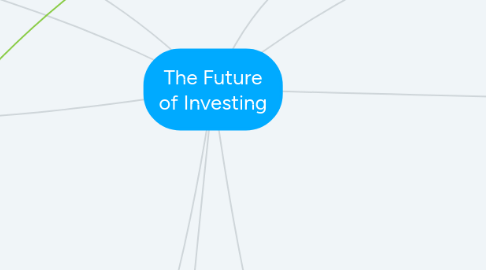
1. Projects (Investments)
1.1. Liquid
1.1.1. Funds
1.1.2. Stocks
1.1.3. Bonds
1.1.4. Currencies
1.1.5. Options
1.2. Illiquid
1.2.1. Real Estate
1.2.1.1. Housing
1.2.1.2. Commercial
1.2.1.3. Mixed
1.2.1.4. Island
1.2.2. Ships
1.2.3. Forest
1.2.4. Alternatives
1.2.5. Funds (PE)
1.2.6. Loans
1.2.7. Rarity
1.2.7.1. Cars
1.2.7.2. Diamonds
1.2.7.3. Wine
1.2.7.4. Art
1.3. Asset Allocation
1.3.1. Optimize Portfolio
2. Noise Ratio Problems
2.1. Lower barriers to entry
2.1.1. SIGNAL: Growth of Robo-investors (i.e. Acorns)
2.1.1.1. Robo-advisors
2.1.1.1.1. Low-cost alternatives
2.1.1.1.2. Legally
2.1.1.1.3. Low starting balances.
2.1.1.1.4. Tax-Loss Harvesting
2.1.1.2. Cost reduction
2.1.1.2.1. Lower barriers of entry
2.1.1.3. Robust system
2.1.1.3.1. Risk analysis
2.1.1.4. Accessibility
2.1.1.5. Increase in investment projects
2.1.1.6. Trending
2.1.1.7. High speed trading (shift from day trading)
2.1.2. Increase first users
2.2. Increase in entrepreneurship
2.2.1. More venture dollars
2.2.2. Time consuming to build companies
2.2.3. More private companies/ layers of capital
2.3. Imbalance
2.3.1. Lack of equity (if companies stay private longer or indefinitely)
3. Financial Education
3.1. Improve awareness & management
3.2. Added value
3.3. New market participants
3.4. Institutions
3.4.1. Schools
3.4.2. Universities
3.5. Online classes- Global class for investing
4. Trust paradigm
4.1. Needs end Consumer
4.1.1. Outcome oriented solutions
4.1.1.1. health care
4.1.1.2. retirement home
4.1.1.3. retirement found
4.2. Non financial services are gaining trust
4.2.1. Amazon
4.2.2. Google
4.2.3. Apple
4.2.4. Alibaba
4.2.4.1. Money Market Found
5. Savings (Awareness, Management, Investment)
5.1. General increase in awareness
5.2. Retirement Plan
5.3. Emergency Fund
5.4. Insurance coverages
5.4.1. Car
5.4.2. House
5.4.3. Medical
6. Impact (outcome-based) Funds // Green-only Funds
6.1. SIGNAL: SUSTAINABLE INVESTING
6.1.1. 85% of the general population interested
6.1.2. 84% want to tailor their investments
6.1.2.1. investment matches interests
6.1.3. Long-term investments
6.1.4. Balance financial gains with social and environmental impact
6.1.5. Need of more product choices
7. Technology
7.1. Tokenization
7.1.1. Crypto
7.2. Blockchain
7.2.1. Proof of ownership
7.2.1.1. Asset digitalization
7.2.2. Proof of identity
7.2.3. Anti-counterfeit solutions
7.2.4. Crowd prediction
7.2.5. Internet of Things
7.2.5.1. Trading/financial platforms
7.3. Granularity
7.4. Accessability
7.5. Platforms
7.6. Apps
7.6.1. Coding
7.6.2. App Stores
7.7. Portals
7.8. Risks
7.8.1. Difficulties with data management
7.8.2. Lack of transparency as algorithms become more complex
8. Constraints
8.1. Laws & restrictions
8.1.1. Body of government
8.1.2. Tax collection
8.1.3. Jurisdiction
8.1.3.1. Investment Classification
8.1.3.1.1. Professional
8.1.3.1.2. Semi-Professional
8.1.3.1.3. Non-Professional
8.2. Self-awareness
9. PARADIGM SHIFTS
9.1. Changing Investing Philosophies
9.1.1. Index-Tracking Funds
9.1.2. Vested Stock (Startups, Increasing)
9.1.3. "Government-Free" Investing: Cryptos, Decentralized
9.2. Finance Access Level
9.2.1. Private, Traditional
9.2.1.1. Banks, AMs, SEs
9.2.2. Private, Institutional
9.2.2.1. INV Banks, Bonds, Projects
9.2.3. Public
9.2.3.1. Government
9.2.3.1.1. Pension Funds
9.2.3.1.2. Cash Injections
9.3. Tech VS Regulation
9.3.1. After-the-fact regulation
9.4. Structural Issues, Preconditions and Considerations with Capitalistic Finance
9.4.1. Investment Requirement: Capital
9.4.1.1. Sources of Capital
9.4.1.1.1. Disposable Income
9.4.1.1.2. Challenged by: Neobanks, Startups, Shadow Banks
9.4.1.1.3. Retirement Plans
9.4.1.1.4. Inherited Capital
9.4.2. Wealth inequalities
9.4.2.1. Wealth Inequality in America: Key Facts & Figures | St. Louis Fed
9.4.2.1.1. The top wealthiest 1% possess 40% of the nation's wealth; the bottom 80% own 7%
9.5. Challenge: The Unbanked
9.5.1. Libra
9.5.2. Airtime / MPESA Models
9.5.3. Challenged by: Crowdfunded AMs, Tokenized Investments
9.5.4. Case: PM Modi (India) withdrawing low-denomination bills from economy.

